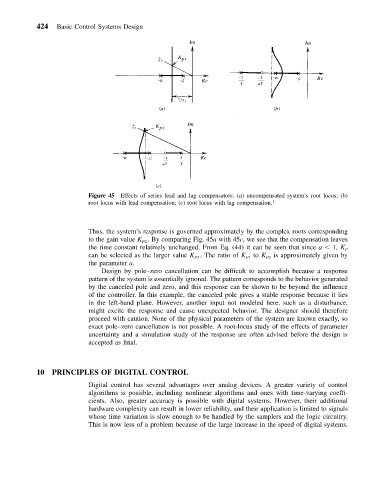Page 433 - Mechanical Engineers' Handbook (Volume 2)
P. 433
424 Basic Control Systems Design
Figure 45 Effects of series lead and lag compensators: (a) uncompensated system’s root locus; (b)
root locus with lead compensation; (c) root locus with lag compensation. 1
Thus, the system’s response is governed approximately by the complex roots corresponding
to the gain value K . By comparing Fig. 45a with 45c, we see that the compensation leaves
P2
the time constant relatively unchanged. From Eq. (44) it can be seen that since a 1, K P
can be selected as the larger value K . The ratio of K P1 to K P2 is approximately given by
P2
the parameter a.
Design by pole–zero cancellation can be difficult to accomplish because a response
pattern of the system is essentially ignored. The pattern corresponds to the behavior generated
by the canceled pole and zero, and this response can be shown to be beyond the influence
of the controller. In this example, the canceled pole gives a stable response because it lies
in the left-hand plane. However, another input not modeled here, such as a disturbance,
might excite the response and cause unexpected behavior. The designer should therefore
proceed with caution. None of the physical parameters of the system are known exactly, so
exact pole–zero cancellation is not possible. A root-locus study of the effects of parameter
uncertainty and a simulation study of the response are often advised before the design is
accepted as final.
10 PRINCIPLES OF DIGITAL CONTROL
Digital control has several advantages over analog devices. A greater variety of control
algorithms is possible, including nonlinear algorithms and ones with time-varying coeffi-
cients. Also, greater accuracy is possible with digital systems. However, their additional
hardware complexity can result in lower reliability, and their application is limited to signals
whose time variation is slow enough to be handled by the samplers and the logic circuitry.
This is now less of a problem because of the large increase in the speed of digital systems.

